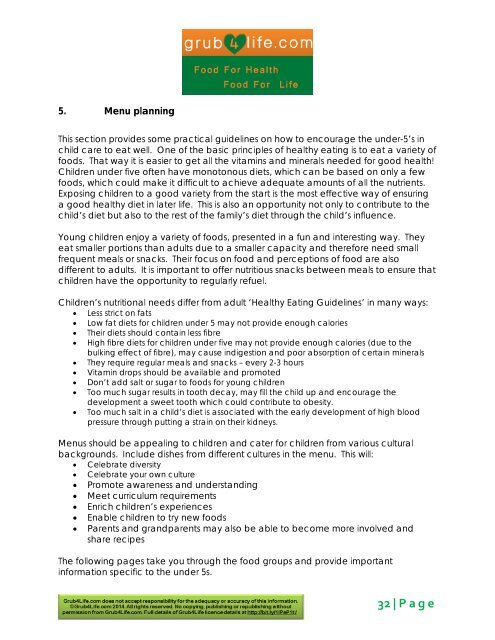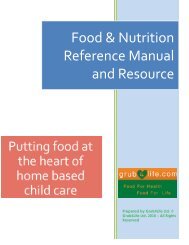Grub4Life Food and Nutrition Reference Manual
You also want an ePaper? Increase the reach of your titles
YUMPU automatically turns print PDFs into web optimized ePapers that Google loves.
5. Menu planning<br />
This section provides some practical guidelines on how to encourage the under-5’s in<br />
child care to eat well. One of the basic principles of healthy eating is to eat a variety of<br />
foods. That way it is easier to get all the vitamins <strong>and</strong> minerals needed for good health!<br />
Children under five often have monotonous diets, which can be based on only a few<br />
foods, which could make it difficult to achieve adequate amounts of all the nutrients.<br />
Exposing children to a good variety from the start is the most effective way of ensuring<br />
a good healthy diet in later life. This is also an opportunity not only to contribute to the<br />
child’s diet but also to the rest of the family’s diet through the child’s influence.<br />
Young children enjoy a variety of foods, presented in a fun <strong>and</strong> interesting way. They<br />
eat smaller portions than adults due to a smaller capacity <strong>and</strong> therefore need small<br />
frequent meals or snacks. Their focus on food <strong>and</strong> perceptions of food are also<br />
different to adults. It is important to offer nutritious snacks between meals to ensure that<br />
children have the opportunity to regularly refuel.<br />
Children’s nutritional needs differ from adult ‘Healthy Eating Guidelines’ in many ways:<br />
• Less strict on fats<br />
• Low fat diets for children under 5 may not provide enough calories<br />
• Their diets should contain less fibre<br />
• High fibre diets for children under five may not provide enough calories (due to the<br />
bulking effect of fibre), may cause indigestion <strong>and</strong> poor absorption of certain minerals<br />
• They require regular meals <strong>and</strong> snacks – every 2-3 hours<br />
• Vitamin drops should be available <strong>and</strong> promoted<br />
• Don’t add salt or sugar to foods for young children<br />
• Too much sugar results in tooth decay, may fill the child up <strong>and</strong> encourage the<br />
development a sweet tooth which could contribute to obesity.<br />
• Too much salt in a child’s diet is associated with the early development of high blood<br />
pressure through putting a strain on their kidneys.<br />
Menus should be appealing to children <strong>and</strong> cater for children from various cultural<br />
backgrounds. Include dishes from different cultures in the menu. This will:<br />
• Celebrate diversity<br />
• Celebrate your own culture<br />
• Promote awareness <strong>and</strong> underst<strong>and</strong>ing<br />
• Meet curriculum requirements<br />
• Enrich children’s experiences<br />
• Enable children to try new foods<br />
• Parents <strong>and</strong> gr<strong>and</strong>parents may also be able to become more involved <strong>and</strong><br />
share recipes<br />
The following pages take you through the food groups <strong>and</strong> provide important<br />
information specific to the under 5s.<br />
32 | Page






